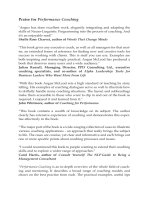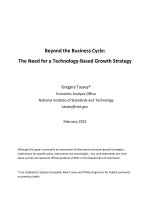Performance Coaching: The Handbook for Managers, HR Professionals and Coaches pot
Bạn đang xem bản rút gọn của tài liệu. Xem và tải ngay bản đầy đủ của tài liệu tại đây (5.04 MB, 313 trang )
Praise for
Performance Coaching
"Angus has done excellent work, elegantly integrating and adapting the
skills of Neuro-Linguistic Programming into the process of coaching. And
it's an enjoyable read!"
Shelle Rose Charvet, author of
Words That Change Minds
"This book gives any executive coach, as well as all managers for that mat-
ter, an extended frame of reference for finding new and creative tools for
success in working with clients. This is stuff you can use. Examples are
both inspiring and reassuringly practical. Angus McLeod has produced a
book that deserves many users and a wide audience."
Julian Russell, Managing Director, PPD Consulting Ltd., executive
coaching specialists, and co-author of
Alpha Leadership: Tools for
Business Leaders Who Want More From Life
"With this book Angus McLeod sets a high standard of teaching by story
telling. His examples of coaching dialogues serve so well to illustrate how
to skilfully handle many coaching situations. The layout and subheadings
make them accessible to those who want to dip in and out of the book as
required. I enjoyed it and learned from it."
John Whitmore, author of
Coaching for Performance
“This book contains a wealth of knowledge on its subject. The author
clearly has extensive experience of coaching and demonstrates this exper-
tise effectively in the book.
“The major part of the book is a wide-ranging collection of cases to illustrate
various coaching applications - an approach that really brings the subject
to life. The cases are concise, yet clear and informative and each brings out
one or more specific points about coaching processes and issues.
“I would recommend this book to people wanting to extend their coaching
skills and to explore a wider range of approaches.”
Carol Harris, author of
Consult Yourself: The NLP Guide to Being a
Management Consultant
“
Performance Coaching
is an in-depth overview of the whole field of coach-
ing and mentoring. It describes a broad range of coaching models and
draws on the best practice from each. The practical examples, useful tips
and mini-transcripts will benefit those new to coaching, and profit sea-
soned old timers as well. We highly recommend this book.”
James Lawley and Penny Tompkins, authors of
Metaphors in Mind:
Transformation through Symbolic Modelling
“The author has achieved the near-impossible - writing a book that dem-
onstrates the potential of coaching as an effective and ethical instrument
for change and gives a flavour of its depth, richness and subtlety, but is
nevertheless accessible, comprehensible and usable for pro and novice
alike. This title deserves to sit - hopefully well-thumbed - alongside the
very limited number of internationally respected books on coaching.”
David Hoad, Coach and HR Consultant, The Kingsmoor Consultancy
“Angus McLeod's
Performance Coaching
is an immensely practical aid to
coaching and works at a level of detail - both in terms of language and
process - that will allow HR professionals and managers alike, even with
little formal coaching experience, to get to the heart of issues and resolve
them elegantly and respectfully.”
Anne Thompson, Group HR Director, Parity Plc
"Effective coaches can make the difference between good and great busi-
ness leaders. This book is packed with practical examples, tools and tips to
help the coach in this task - highly recommended."
Anne Deering, Director, AT Kearney
"As the field of coaching continues to discover the extensive skill-based
models of NLP,
Performance Coaching
by McLeod will become one of the
foundational books. This how-to manual provides an excellent use of NLP
models and skills for coaching. I like it also because it is further enhanced
by integrating much of Gallwey's Inner Game approach."
L. Michael Hall, PhD, Coaching Conversations and Meta-Coaching
Performance
Coaching
The Handbook for Managers, H. R.
Coaching
The Handbook for Managers, H. R.
Coaching
Professionals and Coaches
Angus I McLeod, PhD
MS, Mental Health Counseling
Adjunct Professor, Department of Human Services (Counseling)
Wright State University
Crown House Publishing
www.crownhouse. co.uk
First published by
Crown House Publishing Ltd
Crown Buildings, Bancyfelin, Carmarthen, Wales, SA33 5ND, UK
www.crownhouse.co.uk
and
Crown House Publishing Ltd
P.O. Box 2223, Williston, VT 05495-2223, USA
www.CHPUS.com
© Angus McLeod 2003
First published 2003. Reprinted 2004.
Illustrations by Les Evans
The right of Angus McLeod to be identified as the author of this work
has been asserted by him in accordance with the Copyright, Designs
and Patents Act 1988.
All rights reserved. Except as permitted under current
legislation no part of this work may be photocopied, stored in a retrieval
system, published, performed in public, adapted, broadcast, transmitted,
recorded or reproduced in any form or by any means,
without the prior permission of the copyright owners.
Enquiries should be addressed to
Crown House Publishing Limited.
British Library Cataloguing-in-Publication Data
A catalogue entry for this book is available
from the British Library.
ISBN 1904424058
LCCN 2003102582
Printed and bound in the UK by
The Cromwell Press Ltd
Trowbridge
Wiltshire
Dedication
Diane Fahy Browning (1948–2002)
This book is dedicated to the life of Diane Fahy and to her extended
family and circle, who keep her memory in my mind as well as in
my heart.
Sometimes one is privileged to meet and develop a friendship that
persists through all changes and that is characterized by so much
understanding, commitment, and unconditional love that one is
regularly in awe of it. My friendship with Diane was like that for
over twenty years. Many others enjoyed the same level of friend-
ship and love that she effused. Diane influenced and affected a
multitude of people in and around Delaware, where she settled.
She captivated people with her acute attention and her laughter.
She was a model for positive mindsets in the face of considerable
adversity, both in life and in her dying.
Diane did not have the tools of the coach as described and illus-
trated in this book, but she had the instinctive qualities of a fine
coach. She was a ready listener and she cared passionately about
people, their targets and their aspirations. She dared to challenge
and risk a relationship if she felt that a friend might be moving in
harm’s way, away from their targets and a healthy future. She saw
people as holistic entities; she nurtured and underpinned hopes;
she helped to sketch the dreams from which plans and targets
would arise. She worked from a heart filled with love and with a
mind passionate and hopeful about the human spirit.
A biography about the life of Diane Fahy would make a valuable
and inspiring contribution to literature, but I offer this work to her
memory instead. After she died, many people said, independently,
that an angel had departed this world. I know her to be still with
us. A spirit like hers does not die.
Contents
Acknowledgments v
Preface vii
Chapter One
Introduction
1
Sources of inspiration
3
Defining coaching
4
Principal instruments of the coach
5
Definitions of coaching
9
Chapter Two
Coaching Issues—New Skills
11
Communication
11
Who’s the boss?
20
Feedback
26
Presenting
32
Interpersonal conflict
47
Stuck in a corner
67
Inner conflicts
73
Influencing
90
Chapter Three
Drivers for Change
99
Internal dialogue and self-judgments
100
Emotions
106
Authenticity
119
Negativity
123
Limiting beliefs and rules
126
Lacking compulsion to change
128
Hierarchy of logical levels
128
Walking the logical levels
131
Motivation
141
Chapter Four
Coaching Contract and Practice
161
Freelance coaching
161
Employing external coaches: strengths
and weaknesses
162
Internal coaching provision
163
To whom is the coach responsible?
164
Selling coaching internally
165
Letting coachees know what to expect
before sessions
166
First meeting: preparing for work
166
Scene setting and recapping expectations
167
i
Logistical needs for coaching sessions
169
Behaviors during coaching sessions
170
Neutrality
172
Empathetic projection and expressed sympathy
173
Pacing and leading
174
Breathing
175
Exquisite attention
176
Sensing
176
Instinct
177
Reflecting back issues and language
178
Ending sessions
178
Out-of-session work for the coachee
179
Subsequent sessions work for the coach
180
Chapter
Five
Developmental Models
181
Flexibility of coaching approach in organizations
181
Clean language
182
Symbolic modeling
183
Trance
184
Conversational coaching
185
Provocative coaching
186
The STEPPPA coaching method
189
A footnote on personality profiling models
192
Thinking preferences: filters on our world
193
Chapter Six
Coaching Development
203
Mindsets for the coach
203
Inner-game coaching
204
Mindsets
205
Underpinning values and beliefs
206
Servant leadership
207
People whispering
208
Facilitation
209
Coaching in groups
210
Self-coaching
212
Coach as coachee and observer
213
Changing coaching parameters
213
Two on one
214
Practice groups
216
Inspiration
217
Academic resources
218
Chapter Seven
Other Coaching Tools and Interventions
219
Questioning
219
Context-free questioning
221
Virtual timelines
224
ii
Performance Coaching
Metaphor and symbols
224
Storytelling
227
Chapter Eight
Coaching Pitfalls and How to Avoid Them
Chapter Eight Coaching Pitfalls and How to Avoid Them Chapter Eight
233
Psychological projection
233
Countertransference and inspiration
234
Separateness
236
Interpretation
237
Transference
239
Coachee attraction
241
Other issues in the coaching dynamic
243
Ethics
244
Keen beginnings
245
Pressing on
246
Chapter Nine
Mentoring and E-Mentoring
247
Mentoring
247
E-Mentoring
250
Glossary of Terms
253
Appendix One
A Brief History of Coaching by Steve Breibart
265
Appendix Two
Mindsets for the Coachee
269
Appendix Three
Mentee Feedback to Ask Max
271
Appendix Four
Code of Conduct and Methods for E-Mentors
273
Appendix Five
E-Mentor Questionnaire: An Example
279
Appendix Six
Web Resources
283
Bibliography
285
Further reading
288
About the author
289
Indexes
291
1. Linguistic tips
291
2. Tools
293
3. Main index
295
iii
Contents
Acknowledgments
The idea to write this book came through the development of my
practice and ideas about coaching. There are many friends and col-
leagues in and at the periphery of coaching who have influenced
and helped develop that thinking and who have provided me
with opportunities for growth and change. These include Denise
Fryer, Sue Knight, Lynne Kerry, Carol Harris, James Lawley, Penny
Tompkins, Judith Lowe, Shelle Rose Charvet, Julian Russell, Anne
Deering, Robert Dilts, John Abulafia, and my colleagues in the
Coaching Foundation, Steve Breibart and Sir John Whitmore. I am
also grateful to Steve for his paper on the historical evolution of
coaching and for many Web references given in the appendices.
A number of highly respected and productive people offered to
read and offer comments on my drafts and they each have my grat-
itude and heartfelt thanks. They are Adrienne Carpenter, Angela
O’Connell, Anne Deering, Carol Harris, James Lawley, Jean Kelly,
Jill Dann, Paul Barber, Penny Tompkins, Shelle Rose Charvet,
and Tim Nottidge. Of special note are the contributions of Anne
Thompson and David Hoad, whose comments proved invaluable.
Helen Kinsey helped structure the book and gave me confidence
in the final draft. It was wonderful to have her support for this
first edition. I am grateful to Terry Fieland, the editor at the lead-
ing NLP journal,
Anchor Point
, who agreed to make this work the
subject of their first-ever book serialization.
When it comes to writing a new book, the writer typically embarks
on a solitary expedition in the certain knowledge that he can return
to the comfort of those who support, love, and inspire. In writing
this book, I wish particularly to acknowledge and thank Obie Jane
Mitchell, who has total belief in my projects and who has helped
me, in recent years, always to achieve what I set out to do. Her love
and belief in me are exemplary.
Alison Adcock inspires the creative spirit and its expression (as
so wonderfully demonstrated for the public, in her art) and she
v
continues to quietly support me, steady and true to friendship.
Other friends inspire even in their absence; knowing that their love
persists is a great comfort. Those who knowingly, or otherwise,
contributed to this book include Anne Robinson, Chris Stumpff,
Frances Hall, Ian Brown, Janet and Laszlo Boksanyi, Jill Greenacre,
John Sayle, Maureen Steele, Michelle Evans, and Stephen Carroll.
I continue to enjoy the encouragement and support of my
long-term friend and co-director at Best Performance Ltd., Neil
Davidson. Neil has the most infectious optimism I have ever
witnessed and inspires success. Jean Kelly, my co-director at the
Learning Exchange, is always encouraging and offered me good
advice on the script.
I have been fortunate to have the love and friendship of Dr.
Adrienne Carpenter, who offered me a perfect space to write this
book. Adrienne provided a peaceful and beautiful environment;
understanding and support for the habits of the author who is
committed to writing (and exhibits the ebbs and flows of inspira-
tion); and refreshments and diversions when the author left his
inner world and returned to the world of people.
I thank my daughter, Alex, for her willingness to have an example
of coaching described in this book. Her decisions sometimes make
me fearful, but I am very proud of her self-determination, persis-
tence, and myriad talents.
Last, but not least, I wish to give credit to all those who give me
numerous opportunities to coach and to be coached. A coach
would be severely limited with no experience, from the receiving
end, of the processes and tools of coaching; I have been fortunate
to experience the skilled interventions of numerous professional
and trainee coaches, some of them working from entirely new ori-
entations and experiences. To all of these people, I offer my thanks
and love.
Angus McLeod, PhD
Philadelphia
Performance Coaching
vi
Preface
The executive coach is a fabulously valuable facilitator of change.
The coach is not the player, but an instrument, in service to the art
of the coachee. The aim is to encourage the coachee to extend and
explore their frame of reference, to help them find new and moti-
vating tools for success in all they do and, with luck, inspire them
to continue traits of self-learning that endure over time.
A frame of reference characterizes the nature and extent of the
coachee’s reality, and the coach intervenes to help the coachee
discover new meaning and potential by stretching their frame of
reference, extending their inner representation of the world. The
coachee thus comes to new perspectives and a fresh frame of ref-
erence. These sometimes include a new perception of who they
really are and their true purpose in being—hugely motivating
perceptions .
Over a time, coachees open up to learning in new and inspiring
ways, to self-coach, to self-challenge and redefine their own frame
of reference. These new skills of mental agility assist them in the
effectiveness of their thinking and their actions in other contexts.
The true coach observes miracles as incredible as the transforma-
tion that leads the tiny stirrings of the chrysalis into the bright
magnificence of a butterfly. If one has not felt privileged and
humbled in the act of coaching, one has probably not yet attained
the mantle of the true coach.
Many of our trainees come to coaching bursting with questions for
their coachees. They bombard them, hoping to find a weakness of
either perception or thinking that they may attack and cure. The
performances are breathtaking for all concerned! The transforma-
tion of trainee to coach is evidenced when the direction and pace of
the session seems to be coachee-led. The coach spends more time
listening rather than worrying about their next intervention.
vii
Very few people exhibit the persona of the natural coach as evi-
denced by their inherent qualities and behaviors. Most of us have
limitations. It is hoped that this book will help convince readers
that we may still excel as coaches—by preparing our mindsets for
coaching, by practice and experience.
Our initial motivations to coach may be myriad: a desire to make
a difference, to lead, to be a rounded and professional manager
and communicator, to look self-assured and worldly. However, if
in reading this book I do not leave you with a shifted motivation
for coaching, then I may have failed. This is because I believe that
coaches need to learn that their desires to
do
something and make
a difference need to be directed at themselves and not at their
coachees. A coach with inner targets can make assumptions about
the inner world of their coachee and distract that coachee from
their most influencing path. Ultimately, I suggest, the best work is
done by the coachee and not by the coach, even though the coach
is more or less a catalyst for that.
It is easy to feel compelled by one’s own motivation. When the
coachee learns how to flex their mental resources, they develop
competencies that are not limited to the issue at hand. By devel-
oping themselves, the coachees use their learning in many other
contexts. True coaching unleashes the potential of the coachee for
success and leadership in all contexts, both in work and outside.
Self-directed solutions lead to motivated targets. It’s success in
self-motivated targets that leads to sustained self-motivation. This
is where coaching makes a value-added contribution to successful
management.
Performance Coaching
viii
Chapter One
Introduction
This book is accessible to managers wanting a resource where they
may learn and access information easily. Human-resources (HR)
professionals will find information helpful in deciding whether to
establish a coaching or mentoring function, whether to insource,
outsource, or use support strategies that could include e-mentor-
ing (using an intranet or extranet). The book should appeal to both
the novice coach trying to get a practical handle on coaching skills
and to the more experienced coach wanting to widen their knowl-
edge and to refresh the use of tools that have become rusty.
In trying to achieve an accessible book for all managers, I hope
that I have provided an adequate structure, a functional contents
list, and a detailed index to satisfy all but the most demanding
and methodical expert. I apologize now for the word “coachee”.
Although I dislike this word, I have been unable to find something
well regarded and more acceptable without introducing a new
term. The word “client” will not do, since, in the corporate context,
the client is always the party that pays.
Where a newly introduced tool or idea is mentioned in the text it
is
shown in bold
, and this signifies that a box containing related
information is nearby. This allows any reader who needs more
information to access it while allowing other readers to continue
reading, without having to break their concentration. I hope this
also allows more expert readers with specific skill sets to skip sec-
tions (when they are already familiar with specific tools).
Other emboldened text,
but italicized
, is there to highlight
but italicized, is there to highlightbut italicized
linguistic
, is there to highlight linguistic , is there to highlight
tips that appear in the text. Linguistic tips are referred to in their
own index for ease of reference.
Necessarily, many of the issues given as examples are incomplete:
they are there merely to illustrate ways of approaching an issue
1
and are not a complete transcript of all interventions. As a conse-
quence, not all the issues raised in a given example are complete.
Many of the tools that are illustrated in the examples can be used
in different contexts. It’s hoped that, by reading through examples,
you will become familiar with the tools and language of coaching
and will build on your successes to use the tools fluidly. The choice
of which tool to use in any given situation becomes more obvious
with familiarity and practice.
Following these introductory sections, Chapters Two and Three
are set out to be highly accessible to managers and novice coaches
wanting easy access to practical coaching. Examples reflect typi-
cal issues seen in coaching practice. These offer a readable way
of introducing the language and tools of coaching. Chapter Two
looks at the most typical issues in coaching and Chapter Three fol-
lows this format to highlight typical drivers for change.
HR professionals with coaching experience may like to go directly
to Chapter Four to gain insights into how coaching is applied in
organizations.
In Chapter Five we look at a selection of methods taken from
bigger developmental models that either are, or can be, applied
to coaching. I have been highly selective in choosing those that I
use or have seen to be highly effective. This is necessarily an indi-
vid
ualistic offering. I also introduce my own
STEPPPA
coaching
model
(“STEPPPA” is an acronym whose meaning we will discuss
later).
Chapter Six looks primarily at the development of the coach,
drawing upon a number of philosophies and methods that under-
pin the practice of executive coaching.
Chapter Seven is unapologetically a place where I have put other
background information that has not appeared elsewhere. This
includes some additional information about questioning methods,
and methods that are not invariably part of the coach’s resource,
such as storytelling, totems, and archetypes.
Performance Coaching
2
Chapter Eight considers some of the pitfalls of coaching and prob-
lems that may arise in coaching practice, including psychological
projection and sexual attraction.
Chapter Nine is a brief resource about mentoring, and particularly
e-mentoring, taken mainly from my experiences with Ask Max,
our Internet-based mentoring service. I also mention telephone
mentoring as an adjunct to coaching.
The appendices contain valuable information about the mechan-
ics of setting up the coaching space, relationships between coach
and coachee and between mentor and mentee, feedback sheet,
code of ethics, and a brief history of coaching and mentoring, as
well as a resource for additional reading and Web-based informa-
tion, including some of the courses offered by institutions. Unless
stated, I do not endorse any Web-based resource or any training
course in this work.
Some of my readers will find issues that are close to something
that they face themselves. The solutions to those issues were
specific to the individuals concerned and not likely to be the best
solution for anyone else. Coaching, as opposed to giving advice,
encourages the development of coachee-specific solutions that are
motivating
and appropriate
for them. This also highlights the sepa-
ration between coaching and mentoring: coaching inspires inter-
nally motivated solutions; mentoring invariably offers externally
derived solutions. In this book, I offer a variant on mentoring that
I think offers the best of both worlds, and integrates them.
My books are designed to be picked up and read from any page,
so the indexes are constructed to make the reader’s life easier. If
the structure of the book does not delight you, then do please look
at the contents list and indexes! I hope you will enjoy reading this
book.
Sources of inspiration
I was drawn into coaching from counseling. For years previously,
I was a sound ear to many; on numerous occasions hearing the
life-stories and traumas of people I had not previously spoken to.
3
Introduction
This was long before I had a clue what to say to them. One time,
someone I had never spoken with, not even by way of an introduc-
tion, provided me with a ten-minute medical history!
My approach then was to listen. Often I would then mentor them
by offering solutions. It therefore came as a miracle to me that
people can make improved progress if you let them find their own
solutions. A workshop within our course called “Power of Silence
in Coaching” produces miracles that are testaments to the cathar-
tic potential of coachees, if only coaches will provide a space for
that. I was naturally pulled further into person-centered interven-
tion and undertook co-counseling training. NLP (neurolinguistic
programming) has also contributed heavily. NLP provides great
tools for change but tools do not make a good coach. The
principal
instruments
, used elegantly, provide this. As the father of modern
coaching methods, Tim Gallwey (1999) said, “Principles are more
important than tools.”
My linguistic background was enhanced by the work of David
Grove (“clean language”) and then of Penny Tompkins and James
Lawley (“symbolic modeling”—Lawley and Tompkins, 2000).
These three people have wonderfully presented us with simple
and effective models for exploring the metaphoric world and find-
ing compelling solutions.
Taken together, I provide a source of expertise in the principal
instruments of coaching that will underpin any other skillset or
toolbox you may wish to apply, whether illustrated here or not.
When the principal instruments are coupled with coaching mind-
sets and the many tools illustrated, you will witness stunning
change and performance that may make your heart swell.
Defining coaching
Many people have failed to define coaching because when they
look at the market they find many varieties of “coach” and many
techniques. Some of these techniques seem radically different in
approach. People also discover that many coaches work from
just one discipline in their work, while others, myself included,
work from a range of disciplines. They may find provocative
Performance Coaching
4
coaches, transactional-analysis coaches, life coaches, emotional-
intelligence coaches, and so on. How can one make sense of all
these approaches? I hope to help. We shall start by introducing the
core elements that underpin best practice in all coaching methods.
It is easy to imagine that a new set of tools sold by one or other
brand will make you a coach. They will not. Without a foundation
in principles, an appropriate mental attitude, and linguistic com-
petencies, these tools are all highly limited.
Whatever their discipline, coaches are generally using two or three
of the principal instruments to assist coachees to a defined target.
Therefore, we will start there.
Principal instruments of the coach
The principal instruments of coaching are
silence
,
questions
, and
challenge
(McLeod, 2001). These are used to assist the coachee to
meet their defined targets. Of the three instruments, silence is the
most effective.
Silence
When a coachee makes a discovery, this psychological break-
through in perception, or catharsis, is wholly internal. Even if the
coach is speaking, the contribution of the coach to the actual event
is insignificant. Silence is therefore the dominant of the triad of
the principal instruments. Silence enables the coachee to think and
feel (experience) without being sidetracked by a coach’s agenda.
The real work of coaching is done in the coachee’s episodes of
thinking and feeling in which the coach plays no part other than
silent witness (McLeod, 2002a). The coachee may be re-evaluat-
ing what they thought they knew, exploring a fresh perception on
what they thought was real and fixed, developing new insight on
a situation, understanding the depth and source of their motiva-
tion, and so on. The art of the coach is
not
to know when to be
silent but when to break that silence.
5
Introduction
I coached a sales trainer who is widely respected on the world
stage. Bob had become stuck. Having decided on an important
task he found himself demotivated to accomplish it, let alone
start the job. He told me that he had become frustrated because
the target was important to him but he kept putting it off. Over
the course of the next ten minutes Bob explored his situation with
me. He willingly entered his on-stage sales-trainer state by getting
out of his chair and imagining/experiencing himself before one of
his large audiences, ready to demonstrate his influencing skills to
them. From that state of being, I asked Bob to offer his “stuck-self”
(still metaphysically in the chair) some advice with his problem.
He provided that advice immediately. Shortly afterwards, I asked
Bob to return psychologically to his chair and then to listen to
the best possible advice available from a leading trainer. I simply
read back his exact words in the same tone and pace. There was a
silence laden with spine-tingling suspense and “atmosphere”. Bob
was transformed. His concentration was internal and acute. His
neck colored with blood, his eyes were defocused, and his whole
being became energized. I let the silence run on. It was broken by
Bob, who launched himself to his feet, saying, “I’m doing it right
now! Sorry to cut the session short!” I couldn’t reply because Bob
was already out of the room and on his way to his office. You will
find other examples in this book.
Jill Dann (2003) says, “In coaching, you have to allow prolonged
silences, and intervene to push the coachee to reconnect with the
moment, bringing them back to it and keeping anyone else silent.
If they can revisit the moment they are often astounded by the
range of emotions experienced.” Emotion, once registered (and
whether expressed or not), is a key driver for change. Silence and
emotion are a facilitators of awesome power.
There is another lesson from the session with Bob. The most moti-
vating behaviors come from self-determined processing. I could
have offered Bob the same advice, but would he have leaped out
of his chair and rushed out of the room to act upon it?
Performance Coaching
6
Questions
Questioning is another of the three principal instruments of coach-
ing. We will return often to questioning techniques, because there
is so much ground to cover. For now, it is worth defining why
questions are used in coaching:
• to unlock more information for both coach and coachee
• to assist the coachee to explore available realities
Questioning can be approached in such a way that coachees can
explore issues and reach motivated targets without the coach
having to understand anything about the situation—such things
as the people involved and the time or place to which the issue
relates. This type of questioning is sometimes called
context-free
questioning/coaching. It is particularly useful where the coachee
is dealing with highly sensitive issues, be they emotional, political,
strategic, or interpersonal. For example, they may have a sensitive
issue regarding the senior board member who hired them. By tak-
ing away the need for the coachee to express the details of their
knowledge and experiences, they can roam freely through their
solutions without concerning themselves with the appropriateness
or otherwise of expressing factual information. If a coach is going
to deal with such situations, context-free questioning can be con-
sidered—but more later! For now, we can see that questioning may
support coaching in many ways. Here are just some examples:
• developing understanding of the issue and its context
• exploring historical situations with positive outcomes
• defining what is and is not in the control of the coachee
• redefining the target(s) and the timescales to success
• encouraging new perceptions
• helping the coachee to associate (experience) their situation/
state fully
• helping the coachee to disassociate from their situation and be
more objective
• re-evaluating value judgments
• revisiting limiting beliefs
• recognition of patterns
7
Introduction
• evaluating behaviors in the context of the coachee’s identity
and values
• defining the level of certainty the coachee has about their suc-
cess (motivation)
Questions can help define the boundaries of the coachee’s world-
view. Questions can also assist them to re-evaluate those boundar-
ies and extend what is possible.
Challenge
Challenges have similar outcomes to questions but often the
approach is confrontational. For example, a challenge may require
the reassessment of a firm belief. Challenges can be offered as
statements or questions and can be especially helpful where a
coachee is very stuck in a pattern of negative thought. Here are
examples:
GILES
: I’m useless at presentations!
COACH
: So, you’re the worst presenter on the planet?
GILES
: I’m not that bad.
COACH
: What are you “not that bad” at, in presentations?
Here, the aim of the challenge is to encourage the coachee to
reframe their perception of their abilities so that they may have
the confidence to do something about their skill level. The next
intervention provides a base for that by exploring positives.
JOHN
: The problem is insurmountable!
COACH
: You’re probably right. Let’s ignore it and work on some-
thing else.
JOHN
: I can’t ignore this—I must do something!
COACH
: If I had this problem, where would be the best place for
me to start now?
Here, the challenge is “discounting” the enormity of the issue and
is very likely to get a reaction. In this case, luckily perhaps, the
effect is to accept action. The coach’s question is designed to get
the coachee to dissociate emotionally from the issue and appeals
to their ability to “observe” the problem from outside and at the
Performance Coaching
8
same time to “help” the coach. We will return to other examples of
challenge and of emotionally associated and emotionally dissoci-
ated states again.
Definitions of coaching
We are now in a position to define for the purpose of this book
both coaching and related services. Since our context is work-
based, the terms “executive coaching”, “performance coaching”,
and “coaching” are interchangeable.
Coaching:
The use of silence, questions, and challenge to assist a
coachee toward a defined work-based target. These are often pres-
ent issues or ones that relate to the future.
Performance coaching:
It is sometimes considered that perfor-
mance coaching centers only on mental techniques and targets
without exploration of emotional material or the nitty-gritty of
communication and relationship. This is an absurd idea since a
huge bulk of issues affecting executive performance is about com-
munication and relationships. Also, since emotion is the key ele-
ment of motivation, any coaching method that missed emotional
investment in targets is flawed.
Mentoring:
Mentoring ideally adopts all the skills of coaching.
The best mentoring helps the mentee to find their own solutions
using the three principal instruments. Most mentoring seems to be
on culture-specific advice and suggestions. It contains information
on organizational structures and procedures (e.g., politics, agen-
das and influencing strategies).
Life coaching:
The use of silence, questioning, and challenge to
assist a coachee to a defined personal target.
Counseling:
The use of questioning and silence to assist the indi-
vidual to manage or redefine personal issues. Very often, these are
located in the past.
9
Introduction
Chapter Two
Coaching Issues—New Skills
We will explore numerous examples that deal with typical issues
brought to us during coaching intervention. The first and most
overarching of these is communication.
Communication
In my work as a coach and team facilitator, I guess that 80 percent
of the issues are dominated by communication factors. By “com-
munication” I mean both the quality and appropriateness of spoken
and written words as well as their interpretation by the hearer/
reader. For example, I remember being welcomed to a business
meeting in Pennsylvania with the words, “It’s good that you could
be with us today.” The simple interpretation is clear: my host was
expressing his pleasure at my being there. However, some months
earlier, I had postponed this meeting because my US travels had
been overbooked and my itinerary had to be changed. Therefore,
my immediate reinterpretation of his welcome was, “So, you
finally deigned to grace us with your presence. Now you’re here,
let’s press on quickly before you get bored and have to leave us.”
After I got over that possible meaning I came up with a third inter-
pretation for “It’s good that you could be with us today.” Maybe
he was acknowledging my busy schedule and expressing gratitude
that, in spite of limited time and the location of their plant, I had
agreed to travel out of the way specifically to meet with them.
If a simple, unambiguous phrase containing only positive mes-
sages can be interpreted so differently, it is small wonder that com-
munication is at the heart of so many executive issues. Throughout
the issues examples in this book, you will find that communication
is often at their heart. The key to moving past such communication
shortfalls is invariably
conscious perception
.
11









